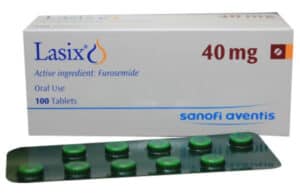Lasix is a diuretic drug that is used in cases of high blood pressure, but what are its other uses, and what is its effect on pregnancy and lactation? Find out the answers to these questions and more information you need to know before using it below.
lasix
- This medicine is available in the form of tablets and ampoules.
- Contains the active ingredient furosemide.
- It is used in cases of fluid accumulation inside the body and high blood pressure.
- It is used only under the supervision of a doctor to determine the appropriate dose according to each case.
What are the ingredients of Lasix?
furosemide (Furosemide): It is an effective substance that belongs to a class of drugs known as loop diuretics, which works to get rid of accumulated fluids in the body and reduce high blood pressure by preventing the reabsorption of water and salts (sodium, chloride and potassium) from the kidneys and increasing the excretion of water and salts with urine. .
The discount is still greater Heal and save
Discount on all skin and hair care products and nutritional supplements

Types of lasix medication
lasix 40 mg tablets: A box containing 24 tablets to be taken orally, with a concentration of 40 mg of the active ingredient furosemide per tablet.
Lasix 20 mg injection: A box containing 3 ampoules for intramuscular or intravenous injection, each ampoule contains 20 mg of the active ingredient furosemide.
tablets lasix 500 mg tablets: Tablets to be taken orally, each tablet contains 500 mg of the active ingredient furosemide.

What are the indications for using lasix? (lasix uses)
This drug is a diuretic, meaning that it stimulates the body to produce more urine, and it is used in cases of:
- Accumulation of fluid in body tissues (edema) or in the abdomen (ascites) as a result of heart or liver disease
- Fluid buildup in tissues (edema) after kidney disease.
- Fluid buildup in tissues (edema) due to burns.
- Fluid buildup in the lung (pulmonary edema) or fluid buildup in the brain (cerebral edema).
- Hypertension.
- Decreased urine production.
Lasix for the treatment of high blood pressure
This drug helps to increase the rate of excretion of fluids and some salts with urine, which contributes to reducing blood volume, which reduces blood pressure in cases that suffer from high blood pressure.
This medicine can be used in cases of high blood pressure alone or with other medicines, depending on the situation and what the doctor determines.
It is not recommended to use it in cases of high blood pressure except under the supervision of a doctor to avoid excretion of large quantities of fluids and salts outside the body, and the patient’s dehydration or severe deficiency in some minerals, as well as to avoid excessive and unwanted drop in blood pressure.
lasix is a diuretic medicine
This medicine contains furosemide, which acts as a diuretic, as it helps to increase the kidneys’ excretion of water and salts out of the body. Therefore, it is used in some cases in which large amounts of water accumulate inside the tissues, in what is known as edema.
Because of the diuretic effect of the drug, it affects the levels of electrolytes inside the body, so the levels of minerals in the body such as sodium and potassium must be monitored and the missing ones must be compensated according to the level of deficiency to protect the patient from any resulting damage.
Lasix 500 uses
The tablets contain a high concentration of furosemide (500 mg), so it can be used in the following cases under intensive medical supervision.
It is used as adjunctive therapy in cases of oliguria and is used to stimulate urine production in the treatment of edema in:
- Patients with acute renal failure.
- Chronic renal failure patients who suffer from fluid retention in the body before dialysis, or when dialysis becomes an unavoidable option, especially in cases of acute pulmonary edema (fluid buildup in the lung).
- Nephrotic syndrome patients with severe impairment of renal function.

What is the dose of Lasix? (lasix dosage)
lasix 40 tablet dosage For adults:
To treat fluid buildup caused by heart, liver, or certain kidney diseases:
The starting dose is 40 mg, which is equivalent to one tablet.
If this dose is not sufficient, it can be doubled after 6 hours to reach 80 mg, equivalent to two tablets. If no improvement occurs, 4 tablets can be taken after another 6 hours.
In exceptional cases, a dose of more than 200 mg can be started under the supervision of a physician.
The maintenance dose usually ranges from 40 to 80 mg, but it should be monitored so that body weight loss due to increased urinary excretion does not exceed 1 kg per day.
For cases of fluid accumulation resulting from burns:
The daily or single dose ranges from 40 (tablets) to 100 mg (two and a half tablets), and doses are adjusted for patients with renal impairment under the supervision of a physician.
For high blood pressure:
One tablet (40 mg) per day, either alone or with other antihypertensive drugs, depending on the condition and as determined by the doctor.
Dosage of lasix 40 tablets for children:
The dose usually ranges between 1 to 2 mg per kilogram of body weight per day, and the recommended dose for children should not exceed 40 mg per day.
Dosage of lasix injection for adults:
To treat fluid buildup in the tissues or abdomen after heart, liver, or kidney disease:
2 to 4 ml (equivalent to 20-40 mg of active substance or 1-2 ampoules) administered intravenously, and it may be necessary to repeat the dose at a specified interval until urine output returns to normal.
Dosages for kidney patients are adjusted under the supervision of a physician.
For cases of fluid accumulation resulting from some burns:
4 to 10 ml (equivalent to 40-100 mg of active substance), and doses should be adjusted for kidney patients under the supervision of a physician.
To treat episodes of high blood pressure:
2 to 4 ml (equivalent to 20-40 mg of active substance or 1-2 ampoules) and is usually used in conjunction with other treatments, depending on each case.
lasix injection doses for kids:
It is used in emergency and life-threatening cases only, especially for those under 15 years of age, and the average daily dose is 0.5 mg of the active substance per one kilogram of body weight, and in exceptional cases the dose may reach 1 mg of the active substance per one kilogram of weight body through a vein.
How to use Lasix?
- This medicine is used only under the supervision of a doctor to determine the appropriate dose according to the condition and age of the patient.
- The lasix tablets are taken by mouth on an empty stomach in the morning with a sufficient amount of water or liquids to be drunk, and the doctor determines the duration of treatment according to each case.
- Ampoules (lasix infusion) are usually injected into a vein slowly under the supervision of a doctor in cases where it is not possible to take tablets, or in cases where urgent and immediate effect is required.
- Ampoules are injected intramuscularly in cases where tablets or intravenous injections are not possible.
- It is preferable not to mix ampoules with any other drugs inside the same syringe.
What are the side effects of Lasix? (side effects of lasix)
Common side effects that occur when using lasix are:
- blood viscosity.
- Disturbances in the balance of electrolytes within the body.
- Low levels of potassium, sodium and chloride in the blood.
- Decreased body water and decreased blood volume.
- High level of cholesterol and some fats in the blood.
- Increased uric acid in the blood.
- Hepatic encephalopathy.
- Reduction of Blood pressure.
- Circulatory disorders.
- High level of creatinine in the blood and an increase in the rate of urine production.
What are the contraindications for using Lasix?
It is forbidden to take this medicine in the following cases:
- Hypersensitivity to any of the components of the drug or to furosemide or sulfonamides.
- Renal failure with anuria that does not respond to treatment with Lasix.
- Hepatic failure with disturbances of consciousness (eg, coma and pre-coma).
- Severe decrease in the level of potassium or sodium in the blood.
- Decreased blood volume or lack of body water (dehydration).
- Breast feeding.
You should talk to the doctor before using the medicine in cases of:
- Reduction of Blood pressure.
- the elderly.
- Use of other blood pressure lowering drugs.
- diabetes.
- gout.
- difficulty urinating
- Prostate enlargement or kidney blockage.
- Low level of protein in the blood.
- Nephropathy.
- Blood flow disturbances in the blood vessels of the brain or heart.
- children.
lasix in pregnancy
Lasix and breastfeeding
The active substance in lasix tab passes into breast milk, and it may reduce the amount of milk produced by the body, so it is not recommended to use this medicine during lactation, and in the event that it is necessary to take it, you must consult a doctor to determine the possibility of completing or stopping breastfeeding according to each case separately.
What are the drug interventions for Lasix?
You must tell the doctor about the medicines you usually take before using lasix medicine to avoid any harmful drug interactions, especially when using some of the following medicines:
- Corticosteroids (anti-inflammatories).
- laxatives
- Non-steroidal anti-inflammatory drugs such as indomethacin and aspirin.
- Probenecid is used to treat gout.
- Methotrexate is a drug for the treatment of rheumatism and an immunosuppressant.
- Phenytoin is a medicine for epilepsy.
- Some heart medications, such as glycosides.
- Antibiotics.
- Immunosuppressant cephalosporins.
- Lithium used for some mental and neurological diseases.
- High blood pressure medications and other diuretics.
- Blood sugar lowering medications.
- Theophylline is a bronchodilator.
Lasix alternative
Similar medicines (medicines that contain the same active ingredient as the medicine):
- Salex.
- Diusex.
- Furoretic.
Alternative medicines (medicines that contain another active ingredient but have the same use as the medicine):
- Burinex.
- Examide.
- Exaretic.
What is the difference between pamabrom and lasix?
Pamabrom is a weak-acting diuretic and is usually used to treat bloating, swelling, a feeling of fullness, and other signs of excess water related to PMS symptoms.
Lasix is a strong-acting diuretic and is used in cases of accumulation of fluid in the tissues of the body or abdomen after a disease of the liver, heart, kidneys, or others. It is also used to reduce high blood pressure, in conjunction with other drugs.
What is the difference between Torsemide and Lasix in terms of effects on the kidneys? (torsemide vs lasix kidney function)
Furosemide (the active ingredient in Lasix) and torsemide both belong to the same class of medications as loop diuretics, which affect a specific part of the kidneys, increasing the excretion of water and salts with the urine out of the body.
Furosemide is the most well-known and most widely used among the diuretics of this drug family in many cases. As for Torsemide, it has a longer effect in terms of a period of time, but the doctor determines the best drug between them according to the condition of each patient.
What is the difference between aldactazide and lasix?
Aldactazide contains two active diuretics, spironolactone and hydrochlorothiazide. This mixture is used to reduce high blood pressure and get rid of fluid accumulation in patients with liver, heart and kidney disease.
Lasix medication contains furosemide, which is also a diuretic and has similar uses, but the mechanisms of action of these substances differ from each other.
Does lasix use a drug for weight loss?
Lasix helps the body get rid of excess fluid Without affecting the fats stored inside the body that cause obesity and weight gain.
It is forbidden to use this drug for weight loss purposes due to the following reasons:
- It does not affect fats and does not increase burning or reduce the storage of more fats.
- It works to remove high amounts of water and salts, which exposes the body to risks if it is not used under the supervision of a doctor.
- It may cause a significant decrease in pressure, which may negatively affect a person’s life.
lasix 20 is used under the supervision of a doctor for the purposes stipulated only, and it is preferable to replace it with supplements and drugs intended for weight loss according to the condition of each patient (under the supervision of specialized doctors).
Does Lasix cause a headache?
Yes, taking this medicine may cause headache as one of the side effects resulting from its use.
Does Lasix cause dizziness?
Taking this medicine may cause dizziness or dizziness, but it must be ensured that the patient does not suffer from dehydration or low blood pressure to the extent that it negatively affects him or threatens his life.
Does Lasix cause constipation?
The use of this medicine can cause constipation in some of its users, and the possibility of constipation increases when they do not drink enough fluids.
Sources
.




نحن نحب سماع آرائكم!
شاركنا رأيك أو اطرح سؤالاً في قسم التعليقات أدناه